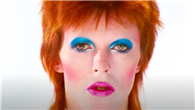A Theme Park Ride of Sound: Remixing David Bowie for Moonage Daydream

With films like “Walk the Line” and “Bohemian Rhapsody” on his résumé, re-recording mixer Paul Massey is no stranger to working with the music of beloved pop acts. But Brett Morgen’s epic David Bowie documentary “Moonage Daydream” had its own unique pressures right out of the gate.
“These songs are iconic, so there was a ‘don’t mess up’ factor, big time,” Massey told IndieWire. “I grew up in London in the ’60s and ’70s, and Bowie was a huge influence at that time, not only on what was being played on the radio but culturally. Throughout his career he would achieve success in one genre of music and then turn 90 degrees left and try another genre. Then he’d throw that up in the air and try something else and succeed at that as well. He carried on doing that in art, music, and fashion all his life.”
The manner in which “Moonage Daydream” tells the story of Bowie’s evolution is as far removed from a conventional documentary format as possible, opting for a largely impressionistic, enveloping sensory experience that conveys not only who Bowie was, but what it might have been like to be David Bowie. The sound design is key to the film’s impact, as boundaries between music, effects, and dialogue are blurred and Massey and his collaborators use the Dolby Atmos sound channels as expressively and aggressively as any film to date. “Brett wanted the movie to essentially be one huge dissolve,” Massey said. “There’s never anywhere where there isn’t music, and there are music and sound effects that weren’t meant to go together working together alongside mash-ups of the songs.”
To execute Morgen’s vision of a “theme park ride of sound,” Massey assembled a team that included his frequent collaborators David Giammarco, John Warhust, and Nina Hartstone. Warhust and Hartstone handled the editorial side from London; Giammarco worked alongside Massey in Los Angeles, where the former mixed effects and the latter focused on dialogue and music. And because the filmmakers had access to Bowie’s archives, Massey found that he had a wealth of material to pull from. “For the concert scenes, I had all the original multitracks with individual instrumentation,” he said. “There was a lot of pressure to stay true to the original mixes, but also to redo them to elevate it all into a theatrical experience.”
“Moonage Daydream”
NEON
Massey was remarkably successful in that regard, moving the individual instruments and sounds across the 100-plus channels made possible by Dolby Atmos to create a surround sound field that gives new meaning to the word “immersive.” “I have never done so much panning in my life, or allowed myself to depend on the surrounds as much as we did on this film,” Massey said. Remixing the tracks with assistance from Bowie’s longtime collaborator and producer Tony Visconti gave Massey a newfound appreciation for the musician’s genius. “You have a lead guitar holding a note in ‘Heroes,’ and you have a fiddle holding that note, and you put the two together and you’re getting harmonics and sounds that I’ve never heard from either a fiddle or a guitar. The result is spectacular. What appeared to be a fairly simple song was actually very, very detailed and complex, which is of course always the case.”
Massey and his team mixed “Moonage Daydream” for multiple formats, including Atmos, IMAX, and more traditional 7.1 and 5.1 theatrical environments. The experience changed the way he looked at sound mixing. “As you get used to working on feature films for Atmos, 7.1, 5.1, home theater, you set restrictions on yourself because you don’t want every single version to be suffering from whatever that particular format is,” he said. “This film taught me to throw away those boundaries and just do it, just remix for every single format, because we couldn’t come up with one approach that would fit all the formats. I think it’s going to change the way I mix in the future. I’ll constantly bear in mind, ‘Can I push that boundary? Can I push that envelope that I originally thought I shouldn’t?’ It was a real lesson.”
Source: Read Full Article

